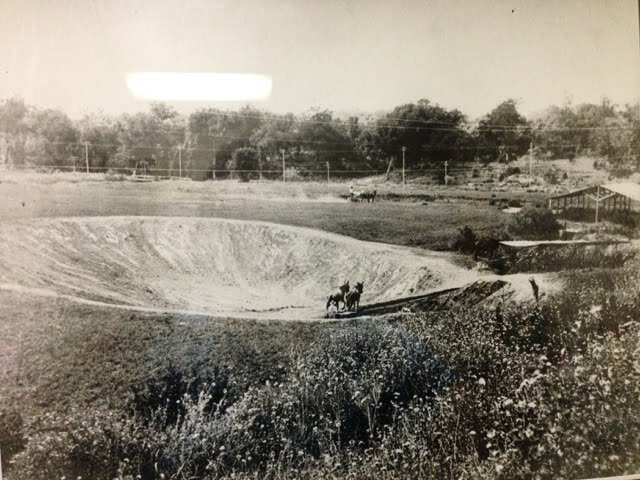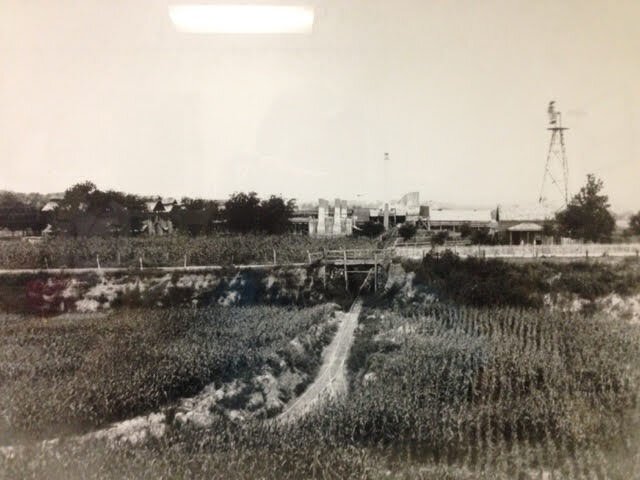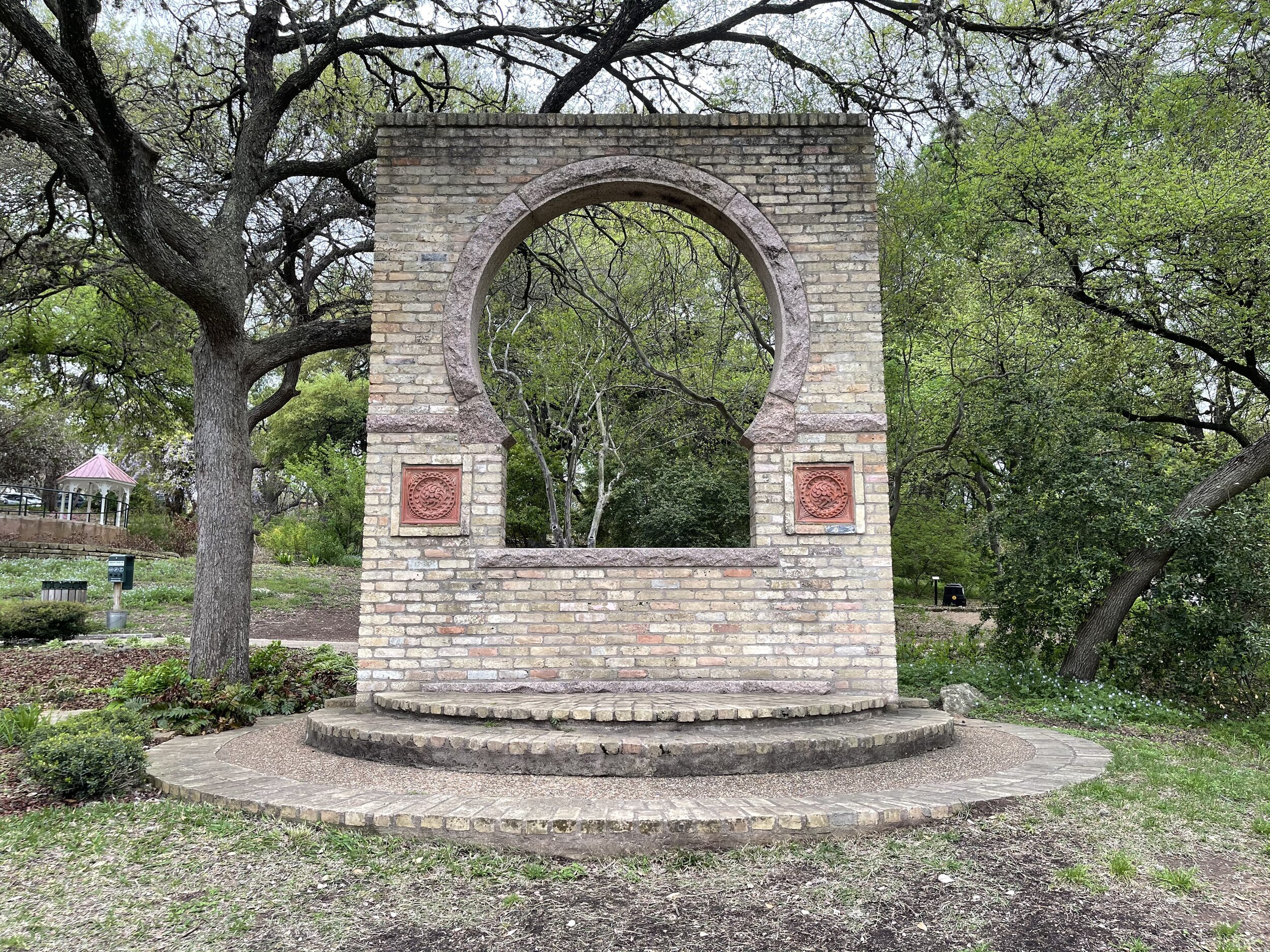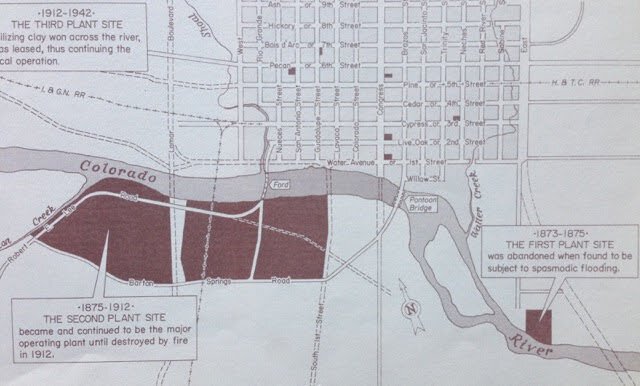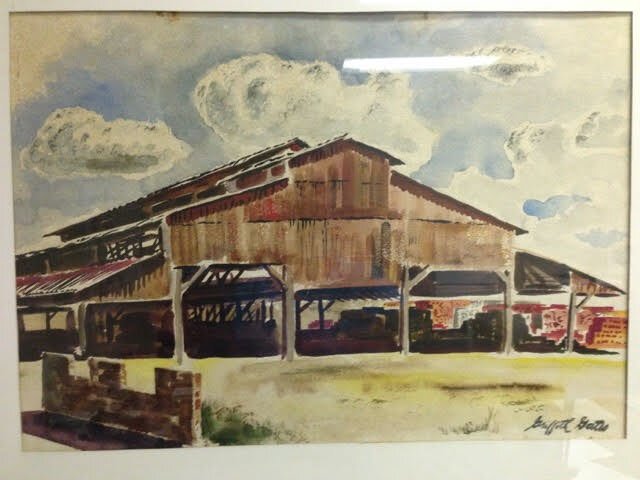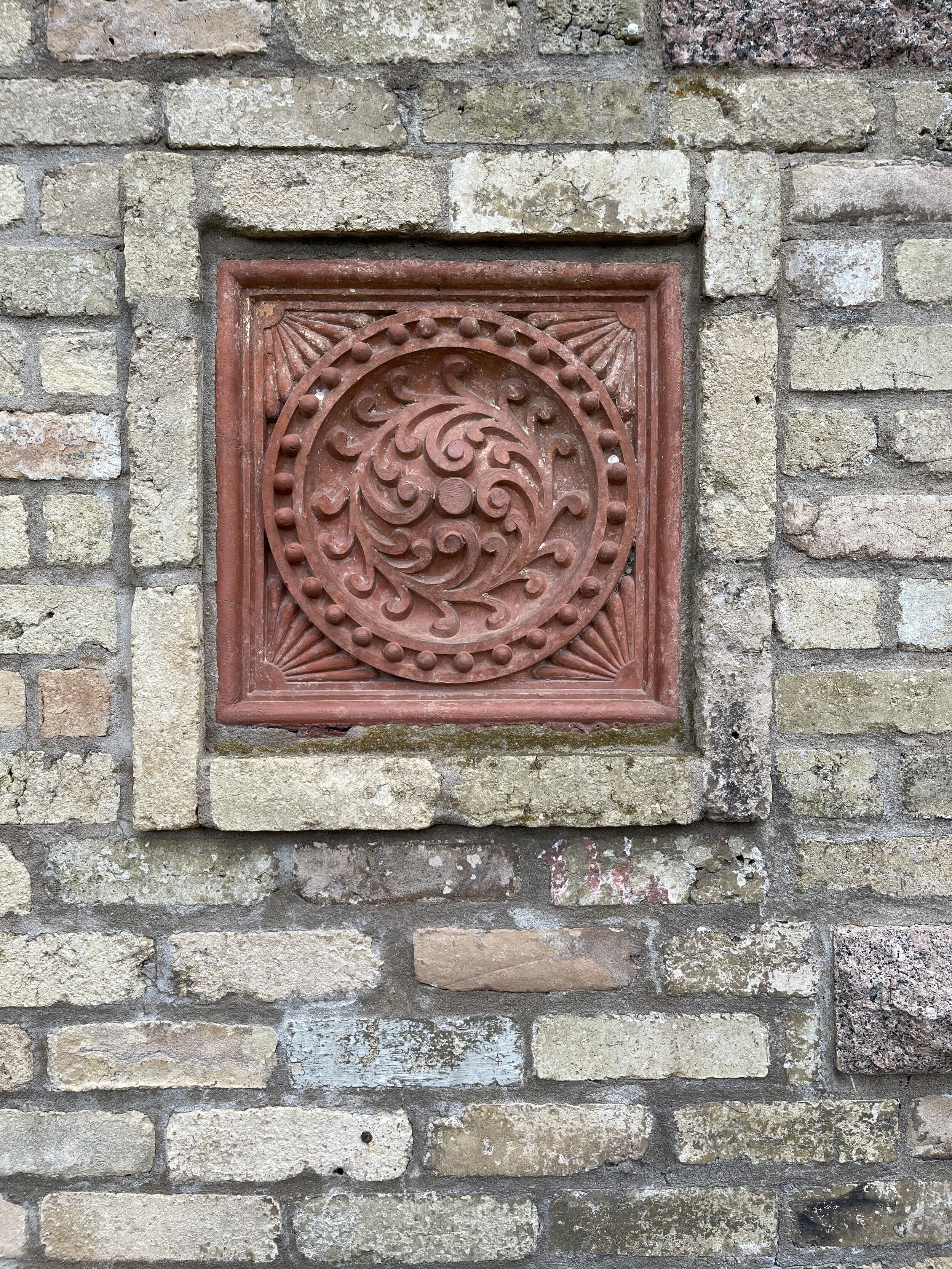Michael Butler & the Butler Brick Legacy
BY PHOEBE ALLEN
Butler family in September 1898. From left to right are Mary (aged 44), John F. (aged 19), Thomas J. (aged 14), Mary Margaret (aged 17) and Michael Butler (aged 54).
Irishman Michael Butler arrived in Austin in 1873 and began manufacturing mud bricks at the foot of East Avenue (now IH-35) on the north bank of the Colorado River. An 1875 flood resulted in his move to the south bank of the Colorado River – between Barton Creek and today’s South First Street and between the river and Barton Springs Road – at brickyards that remained in place until 1958.
Butler bricks were Austin’s building blocks. Most of the brick structures constructed in Austin from 1873 until 1912 used Butler’s “Austin common” buff bricks, manufactured from the alluvial clay deposited by the Colorado River. UT’s Old Main building and the 1888 State Capitol both utilized Butler’s bricks. Butler Brick Company and the subsequent Elgin-Butler Brick Company have distributed high quality bricks all over Texas as well as nationally and internationally.
Beginnings
Michael Butler (1842-1909) was born near Limerick City, Ireland. His father owned farms and was a contractor in the construction of public pikes and roads. In 1866, at the age of 24, Michael sailed to New York City, where he learned the rudiments of his trade as a bricklayer’s helper. Within the next three years he pursued his trade as a mason in Wisconsin, St. Louis, and Little Rock before a move to Dallas in 1869, where he established his first plant for manufacturing bricks using clay from the banks of the Trinity River.
Clay field at Butler Plant #3, in today’s Zilker Park.
Butler’s Dallas Plant (1869-1873) produced handmade bricks, the clay set in wooden molds using the “soft mud” process. According to Austin architect August Watkins Harris, a lifelong friend of the Butler family who chronicled the Elgin-Butler Brick Company in 1963 for the company’s 90th anniversary:
Here he installed one of the first devices of its kind seen in Texas, patterned upon the implement used in grinding the coffee-bean and bearing the name “Coffee-Mill” machine, used in forcing the softened mud into the moulds. The product was dried out in the open, the brick being covered with cloth which could be dampened to prevent accelerated shrinkage, as well as providing protection against inclement weather, the finished article being what was known to the trade as “sun-dried brick.” He used rectangular, up-draft kilns, starting with two, and soon adding two more, each having a capacity of 200,000 units.1
Austin’s Building Blocks
Michael Butler established his first Austin brickyard, Plant #1, at the foot of East Avenue (now IH-35) on the north shore of the Colorado River in 1873. His technique for testing clay to see if it would make good brick was to taste it.4 The plant utilized the same type of Coffee-Mill machine and processes of manufacturing as in Dallas to produce the sun-dried bricks until 1875, when a flood destroyed the site. “He had several buildings here, including three kilns for drying the brick that could hold about 100,000 each. He also had a machinery house and a barn for the mules that were used to haul the brick wagons.”
In 1876, Butler purchased property for his Austin Plant #2 along the south bank of the Colorado River – between the river and Barton Creek Road, and from Barton Creek on the west to the I&GN Railroad right of way (east of Lamar Boulevard) and beyond to South First Street on the east. The clay fields were at today’s Butler Golf Park. Brick was delivered by ox cart across the river ford at the foot of Shoal Creek or over a pontoon bridge at the foot of Brazos Street. A ferry was used during periods of high water.
Butler Fields
In 1877 a new apparatus, the “Sword Machine” replaced the “Coffee-Mill” machine, improving the quality and quantity of production at the new plant. It could fill eight molds.6 In an 1884 article from the Austin Daily Statesman, the reporter states:
In the spring of 1875 Mr. Butler purchased thirty-two acres of land on the south side of the river, erected works and commenced the manufacture of bricks, using old style machines. …today he has the best equipped and most complete works in the state. …Monday next Mr. Butler will put in operation his mud machine…The total will then reach the enormous number of 36,000 per day, or 11,268,000 per year, counting every working day. …Mr. Butler employs between fifty and seventy-five men in the different branches of his business, has four teams constantly delivering orders, and, in brief, turns out more bricks than any yard in the state.
Butler Mansion
Michael Butler married Mary Jane Kelly (1854-1935) in 1878 in St. Patrick’s Catholic Church. They lived in a brick house built by Butler in 1877 at 200 South Lamar, near today’s Zach Scott Theater. All three of their children were born in this home: John Francis in 1879, Mary Margaret in 1881, and Thomas James in 1885.
Butler Mansion Painting
On December 20, 1887, the young family moved into a new home on the northwest corner of 11th & Guadalupe Streets. Architect Thomas Harding of Little Rock, a close friend of Michael Butler from his earlier days in Arkansas, designed the house, which utilized both Butler bricks and Marble Falls granite shipped at the same time as that for the State Capitol.
The Butler Mansion featured rooms laid out in geometric shapes, with two octagons and no rectangles or squares. Granite was used for windowsills, window frames, and decorative arches. The home’s Gothic influence “is reflected in its turrets – some round, some angular – and in the carved terra cotta gargoyles, which lend a quaint, castle-like charm.”
The elegant house was sold in 1966. The new owner leased it as an antique shop. Louis Marks of Houston bought it in 1971 and demolished it for a parking lot. Its Moorish-style arch from the main doorway is now located on the grounds of the Zilker Garden Center with an historic marker. Part of its Victorian wooden porch detail can be seen on the façade of a house at 1112 West 6th Street. Bricks from the interior were used in a house at 6405 Mesa Drive. Bricks, stairway and other details were added to a house at 500 West 13th Street
In 1886, a new and more powerful brickmaking machine was in operation, turning out thousands of brick daily.
Preserved window from the Butler Mansion in Zilker Botanical Garden
Between 1883 and 1899, The University of Texas’ Old Main building’s Victorian-Gothic wings were completed in three stages, each utilizing Butler bricks. By 1888, the new Capitol was completed, using almost three million Butler bricks in its supporting interior walls. Construction for the Union Passenger Depot of I&GN Railroad at Congress Avenue & Third Street was also begun. In 1892, Butler was listed on the Board of Directors of George Littlefield’s new American National Bank. An Austin Daily Statesman article from that same year reads:
The yards are located on the south side of the river, just west of the International and Great Northern railroad. As we crossed the bridge and turned to the right on the Barton Springs road, the reporter’s attention was called to eighty-six acres fronting on the river. “This, said Mr. Butler, “is a piece of property I bought a few years ago and have since had all the timber cut and hauled off, and you can see by the number of stumps that the growth was very thick. It was impossible to see the city from this road before I had the trees cut down.” There are a number of small houses on this land, occupied by the families of most of the men who work in and around the yards, which are located at the west end of this property and occupying ten acres.
Map of Butler plants in Austin (The Elgin Butler Brick Company: 1873-1963)
In 1895, a patent was issued for Butler’s labor-saving device for brickyards. A spur track ran into the brick yard and the molds were placed on a wooden pallet that was sprinkled with sand and then the mud added. The men were paid according to the amount of brick they turned out and were sometimes limited because there was no room to store or dry the bricks. About ten new drying sheds were built, each about 140 feet long and eight feet wide, along with new kilns. New machines were added to make the bricks, which were placed six bricks to a platen and stored under the drying sheds that replaced the older method of covering the brick with canvas and brush. The kilns were powered by wood obtained in the hills up river and floated to the plant, or later by lignite coal from Rockdale and Bastrop. Oil, and later natural gas, gradually replaced the coal.
From 1873 to 1912, Austin’s brick buildings were built primarily with Butler brick. These include the Schneider Store, Tipps Building, Hirshfield House, Smoot House, and numerous residential fireplaces. Eighty percent of the early brick buildings at the University of Texas at Austin were of Butler brick, including Garrison Hall and Gregory Gym. About one and a half million of the bricks used in constructing the Old Main building were reused in the 1937 Main Building.
Elgin-Butler Brick Company
In 1896, Michael Butler sent his son, John Francis Butler, to Ohio State University to study ceramics engineering for three years. When he returned to Austin, John built a lab at the South Austin plant site to analyze the clay and a test-kiln for determining shrinkage, color and refractory characteristics. He also began scouting for desirable clay minerals. While on a visit to appraise and purchase wood, John discovered highly satisfactory clay deposits near Elgin along Sandy Creek. He persuaded his father to buy the land and John Francis moved there to establish ElginButler Brick. A plant was constructed and began operation in 1901. It shipped its first consignment of bricks in 1903.
The Butler Plant #2 Shed
On October 9, 1903, a charter of the Elgin-Butler Brick and Tile Company was completed between M. Butler, W.H. Rivers, and Leon Keeble (directors), and Thomas Pfeiffer and J.B. Morrison. In 1907, Elgin Pottery Company was formed by Mike Butler, W.G. Sneed and W.H. Rivers for the purpose of manufacturing terra cotta, enameled brick, clay furnaces, flue thimbles, flower pots, fire clay slabs, and floor tile. Located at Butler, Texas, contiguous to the brick plant and six miles east of Elgin, this Elgin-Butler Plant is still in operation.
According to a 2015 interview with Michael Butler’s great grandson, Russ Butler, current vice-president of Elgin-Butler Brick Company:
About this time a kind of industrial type of revolution took place in the brick industry. Brick that were being made by the wood mold process started being made by the Dry Press Method – a process in which they would take the clay and, without putting any water with it, grind it and mechanically press it into shape with a large machine. Firebricks from Butler, Texas were made by this process, and they continue to be made this way today. Just about every residential fireplace firebox you see in the Southwest is made of firebrick from Butler, Texas and if you look, the brick probably have the Butler name stamped on them.
The Dry Press Method was a great advancement, but what really revolutionized the industry was the development of strong Portland Cement Mortars and the ability of the brick makers to make high strength structural clay tile. The tile were so strong when used with the Portland Cement Mortars, walls that were being build three feet thick could be reduced to walls that were, maybe, eight or twelve inches thick and have the same load bearing capacity. The company continues to manufacture structural clay tile, but most of it has a glaze applied to it and is called structural glazed clay tile.
Austin Plant #3
Michael Butler died at his home in 1909 at the age of 67. He had been in ill health since 1907, at which time he asked his son Tom to take over the Austin plant. Tom ran the Austin plant until 1912, when the estimated value of the plant was about $80,000.
Detail Shot of the Preserved Butler Mansion Window
By 1903, Andrew Zilker had put in a competing brick works, the ABC or Austin Brick Company. Since there was no clay on the north side of the river, Zilker built a tramline with twelve mule-drawn buckets, each with a capacity of a half yard of clay. The tramway, supported by three large masonry towers and a metal tower, delivered the buckets of clay from what later became the great lawns of Zilker Park, east of today’s MoPac bridge, to a manufacturing plant on the north side of the river. The tram connected facilities on the south bank of the Colorado River with the brickmaking facility on the top of the bluff behind what is now known as Austin High School.
In 1912, following a fire at Butler Plant #2, Zilker offered the Butler family a lease on his plant. Tom and John Butler, together with brother-in-law Walter Walne, signed a 99-year lease for the 53-acre property and hauled the clay via Zilker’s tramlines to this Butler Plant #3 site until 1942. The old boom and hopper – the double-tower supports for the tramline – are still standing on the north side of the river, along the Hike & Bike Trail.
During World War II, the plant manufactured supplies for Armed Forces installations and other industries supporting the war effort. The Austin brickyards, however, were placed on a standby basis due to war restrictions and price freezes on products. Thus, all brickmaking work was moved to Elgin. The Austin Plant #2 was used for storage until its demolition in 1958; it was never reactivated after the war. The brickyards in Plant #2 and Plant #3 were demolished in 1958. The Butlers’ first family home on South Lamar, occupied by Michael Butler’s nephew John J. Butler for a time, was sold and demolished that same year.
Elgin-Butler Brick Company Today
Subsequent to the death of Mrs. Michael Butler, a board of directors for ElginButler Brick was formed among the family members. John Francis Butler, as the eldest, became chairman of the board, and Thomas James Butler, the president of the company.
With the widespread manufacture of concrete blocks beginning in the early 1900s (the first house built entirely with concrete blocks was on Staten Island, New York in 1937), the structural clay tile industry was almost wiped out beginning in the 1950s. Today’s Elgin-Butler Brick thrives, however, and the company continues to produce outstanding firebrick and has developed a specialty in structural glazed tiles, which are highly stain resistant and used nationally and internationally in operating rooms, hospitals, meat packing plants, subways and many other structures.
The Elgin-Butler Company has its central operations on a 500-acre site in Butler, five miles east of Elgin, and sales officein Austin. The family business, owned and operated by four generations of Butlers, was sold in 2005. Butler family members continue to serve in various positions.
THIS ARTICLE WAS WRITTEN FOR PRESERVATION AUSTIN’S SUMMER 2016 NEWSLETTER. READ OUR COMPLETE NEWSLETTER ARCHIVE HERE.


